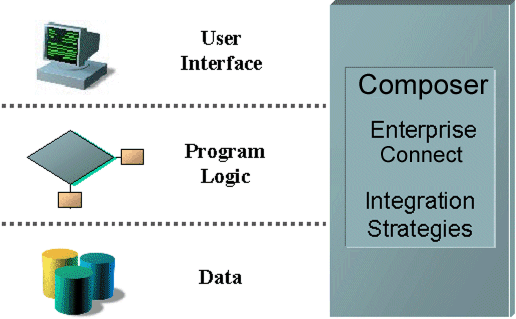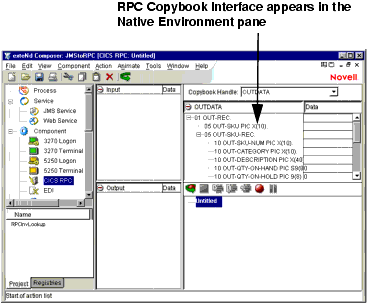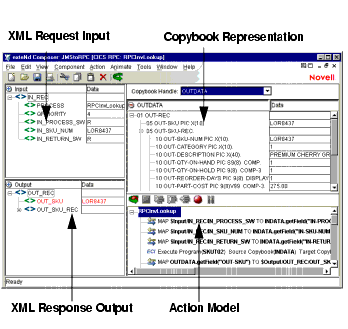


              |  |
 |
 |
 |
 |
 |
 |
 |
 |
 |
 |
CICS RPC Connect User's Guide
CHAPTER 1
Welcome to the CICS RPC Connect Guide. This Guide is a companion to the exteNd Composer User's Guide, which details how to use all the features of Composer, except the Connect Component Editors. So, if you haven't looked at the Composer User's Guide yet, please familiarize yourself with it before using this Guide.
Novell exteNd Composer provides separate Component Editors for each Connect, like CICS RPC. The special features of each component editor are described in separate Guides like this one.
If you have been using exteNd Composer, and are familiar with the core component editor, the XML Map Component Editor, then this Guide should get you started with the CICS RPC Component Editor.
Before you begin working with the CICS RPC Connect, you must have it installed into your existing exteNd Composer. Likewise, before you can run any Services built with this Connection the Composer Enterprise Server environment, you must have already installed the Server software for this Connect into Novell exteNd Enterprise Server.
NOTE: To be successful with this Component Editor, you must be familiar with the basics of CICS and the COBOL programming language as well as the programs with which you wish to interface.
Novell exteNd Composer is built upon a simple hub and spoke architecture. The hub is a robust XML transformation engine that accepts requests via XML documents, performs transformation processes on those documents, and interfaces with XML enabled applications which returns a XML response document. The spokes or Connects are plug-in modules that "XML enable" sources of data that are not XML aware, bringing their data into the hub for processing as XML. These data sources can be anything from legacy COBOL applications to Message Queues to HTML pages.
CICS RPC Connect can be categorized by the integration strategy each one employs to XML enable an information source. The integration strategies are a reflection of the major divisions used in modern systems designs for Internet-based computing architectures. Depending on your B2B needs, and architecture of your legacy applications, exteNd can integrate your business systems at the User Interface, Logic, or Data Levels.

CICS RPC is an acronym for Customer Information Control System - Remote Procedure Call. The CICS RPC Connect XML enables legacy system data using the Logic integration strategy. The CICS RPC component provides the ability to interface with CICS managed programs using CICS' External Call Interface (ECI) and exchange data directly with the programs running in a CICS Region using the standard communication area commonly referred to as the DFHCOMMAREA. Novell exteNd relies on being provided a representation of the communication area as is often defined in applications via a copybook.
The Novell exteNd CICS RPC Connect was designed specifically to work in the CICS environment through IBM's CICS Java Gateway. The Java gateway can reside on the same platform as the CICS region or on a separate platform depending on your system architecture. CICS is an IBM transaction-processing environment that often resides on an IBM mainframe using IBM's proprietary EBCDIC character-encoding scheme, but can also be run under IBM's TXSeries product line on other platforms that support other character encoding schemes.
CICS RPC Connect uses copybook representation of the DFHCOMMAREA as the data interface presented to the XML transformation hub. These copybooks appear in the native environment pane of the CICS RPC Component Editor. Once there, the data can be converted, transformed, or transferred the same as any other XML document.

Much like the XML Map component, the CICS RPC component is designed to map, transform, and transfer data between two different XML templates (i.e., request and response XML documents). However, it is specialized to make a connection to a CICS program via ECI, process the data using elements from a DOM, and then map the results to an output DOM. You can then act upon the output DOM in any way that makes sense for your organization, including displaying the output to a web site. In essence, you're able to push XML data into and/or pull data as XML from a legacy system without ever having to alter the legacy system itself. A CICS RPC Component can perform simple data manipulations, such as mapping and transferring data from one XML document to another, or from an XML document to a program. It can also perform sophisticated manipulations, such as performing multi row mapping (in reference to an OCCURS clause). The CICS RPC Component can also perform all the actions available in a XML Map Component including; process XSL, send mail, and post and receive XML documents using the HTTP protocol.
The following illustration shows how a CICS RPC component uses an ECI connection to interact with data on the mainframe.

The CICS RPC Component Editor allows you to extend any XML integration application you are building (refer to the exteNd Composer User's Guide) to include any CICS business application that supports ECI interactions. For example, you may have an application that retrieves the description, picture, price and inventory status of a product from the database(s) that are updated on a scheduled basis and displays in a Web browser. By using the CICS RPC Component Editor, you can now get the current product information from the operational systems and the static information (e.g., the picture) from the database(s) and merge the information from these separate sources before it displays to a user. This provides the same current information to both internal and external users.
Copyright © 2003 Novell, Inc. All rights reserved. Copyright © 1997, 1998, 1999, 2000, 2001, 2002, 2003 SilverStream Software, LLC. All rights reserved. more ...